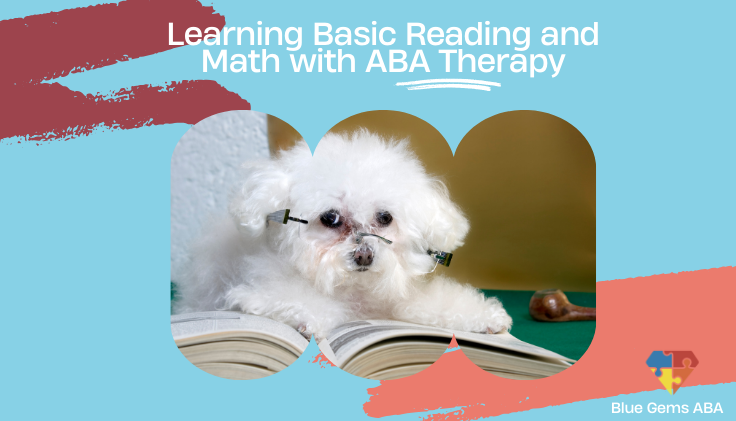Learning Basic Reading and Math with ABA Therapy
Educational instruction follows a rather standard approach to teaching. In most classrooms, this is necessary, as there are multiple students who are trying to learn the same concepts at the same time.
For many children, these standard methods work. Children with autism spectrum disorder (ASD), though, may not be able to grasp the same concepts in the same way that other children do.
All children learn differently, but it’s especially so for children who have autism. In many cases, it’s not that children on the autism spectrum don’t have the ability to learn academic skills such as basic reading and math; it’s just that they require a different approach to instruction.
While applied behavior analysis (ABA therapy) is often seen as a treatment for younger children on the autism spectrum, its principles can be applied to school-aged children to help them learn academic subjects.
In this article, we’ll discuss how ABA therapy can help children learn basic reading and math.
Table Of Contents
How ABA Therapy Builds a Foundation for Success
Autism can affect people in many different ways, but two of the most common challenges people with ASD face are a deficit in communication and social skills. ABA therapy is well-renowned for helping children build these skills over time, in one-on-one settings and through personalized treatment plans with targeted goals.
Social and communication skills form the foundation for many other skills in life. Children start developing these at a very young age, even before they are able to talk.
Children who have autism, though, may not only experience a delay in reaching developmental milestones in these areas, but may have trouble building the skills in the same way as neurotypical peers.
What ABA therapy does is use evidence-based tools and strategies to help children with autism build these essential life skills. By using positive reinforcement and other approaches, children are more effectively able to grasp the concepts and build the skills, which they will then use to learn and grow more in other facets of their life.
How Can ABA Therapy Teach Basic Reading Skills?
Once children begin to build social and communication skills, they can move onto more complex tasks such as reading. In reality, they will be exposed to some of the basics of reading when they are building these social and communication skills, too — things such as recognizing letters and labeling items with words.
Reading, after all, is about much more than just being able to recognize words in their written form. It’s also about understanding what the words mean, how they work together in conjunction with other words and then remembering the things that you have read.

It may not seem like it for adults, but reading is actually a complex skill to master — and one that children with autism might struggle with.
ABA therapy can help break this complex skill down into more manageable steps, with positive reinforcement integrated along the way for every successful step accomplished.
An example might be recognizing the letters and phonics first before moving onto recognizing full words and their meaning. Then, once these skills are mastered, the child can move onto understanding the meaning of longer phrases and sentences, before finally developing understanding of full stories and being able to analyze them.
How Can ABA Therapy Teach Basic Math Skills?
In similar ways, children with ASD are exposed to the basic building blocks of math skills through ABA therapy as they gain communication and social skills. They will be taught numbers, how to identify them and the words associated with them, for example.
Taking those concepts to the next level to complete even basic math, though, can often present a challenge for children on the autism spectrum. ABA therapy will, again, break these concepts down into more manageable steps, using many visual and physical aids to help along the way.
This could include starting with physical objects that can represent numbers, such as blocks or another item that the child uses. Stacking one on top of the other — or removing one from a stack — the child can learn the basics of addition and subtraction.
A next step would be progressing to visual aids instead of physical objects, which helps them understand that math concepts extend beyond just the physical objects. Finally, they can transition to other math concepts in a more abstract way by removing the visual aids and writing problems down on paper.
| Area of Learning | ABA Strategy | Progression Steps |
|---|---|---|
| Communication & Social Skills | Positive reinforcement, one-on-one therapy | Eye contact → Labeling → Expressive language |
| Reading | Letter/phonics recognition → Word identification → Sentence comprehension | Letters → Words → Sentences → Stories |
| Math | Visual & physical aids → Abstract thinking | Physical objects → Visual aids → Written problems |
Blue Gems ABA Helps Children Build Academic Skills for Success
ABA therapy is a very well-rounded treatment plan for children on the autism spectrum. While it starts with fundamental skills such as communication, social interaction and behavior modification, it can also provide a solid base for learning academic skills such as basic reading and math.
At Blue Gems ABA, our team of experienced therapists helps children with autism building academic skills for success throughout life. Everything we do is to help support each individual child in the best way possible for their unique strengths and challenges.
To learn more, please contact us today.




